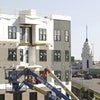Idiosyncratic WooSox stadium may include diner car
 Image/Courtesy
A preliminary rendering of a mixed-use development for Worcester's Canal District, which is expected to rise next to a ballpark, as seen in the background. Design work for the project is ongoing.
Image/Courtesy
A preliminary rendering of a mixed-use development for Worcester's Canal District, which is expected to rise next to a ballpark, as seen in the background. Design work for the project is ongoing.
When the city of Worcester and the Pawtucket Red Sox announced last August they had a deal to move the team to Worcester, officials showed renderings of a ballpark with Fenway Park's Green Monster and a traditional brick exterior common to modern ballparks.
But those design elements are no sure thing, the project's architects said Tuesday, leaving the look of Worcester's soon-to-be ballpark up in the air.
The Green Monster replica appears to be out. The red brick may be, too.
"We've asked the design team to think of what's right for Worcester and not what happens in every other ballpark," said Janet Marie Smith, an architect for the Los Angeles Dodgers who is serving as an advisor for the project. "I doubt you'll see red brick, but it's all yet to be determined."
Two design firms have been hired for the $101-million ballpark, which is slated to open in 2021. D'Agostino Izzo Quirk Architects of Somerville are designing the ballpark itself, and Sasaki, which has offices in Watertown and Shanghai, is working on the mixed-use neighborhood envisioned to grow on the surrounding blocks in Worcester's Canal District.
Site work for the ballpark is expected to begin off Madison Street in July while design work is finalized, said Thomas Quirk, a Worcester native and president of D'Agostino Izzo Quirk Architects, known as DAIQ.
Representatives from both firms, along with top officials from the city and the PawSox, met with the press in City Hall on Tuesday to update the planning process and emphasize they were working to make the project unique to Worcester. Among the features being discussed is a diner car, though planners stressed that nothing is finalized.
City Manager Edward Augustus said the Canal District site, with a sloping topography beyond where the outfield would be built, could enable a backdrop unlike any other park.
"The site is idiosyncratic," he said. "That's driving, I think, idiosyncratic design opportunities."
The ballpark is aimed at bringing life back to a long-dormant part of the Canal District that has languished with a large contaminated site where the ballpark would go and some scattered lower-density industrial businesses. Planners said they hoped to make the park itself as open to the public as they can, including allowing people to walk up close to the outfield walls when games aren't being played.
PawSox Chairman Larry Lucchino said the park won't be secluded from the rest of the city or surrounded by parking lots like many ballparks used to be.
"This is not your father's ballpark," Lucchino said.
The ballpark, to be called Polar Park thanks to a naming rights deal with Worcester drink manufacturer Polar Beverages, will draw new investment to the neighborhood, city officials have said. A mixed-use development is envisioned for two hotels, 225 residential units, 65,000 square feet of retail space, and 200,000 square feet of residential, office or other space.
New revenue from that development is expected by the city to pay back the city's $101 million bond for the park, along with rent and other payments from the team.
Smith, who designed Oriole Park at Camden Yards and modern upgrades to Fenway Park — both seen as gold standards among ballparks — said the park will likely include plenty of flexible seating arrangements allowing for more social interactions than the fixed seats fans would be used to in older parks, including McCoy Stadium, where the PawSox now play.
The first look he public got last summer of the Worcester ballpark was more of a placeholder than something indicating a settled design, she said.
"That was never meant to be an architectural statement," Smith said.
Lucchino emphasized that Polar Park isn't being designed to imitate anything else.
"We're not looking to the last example to mimic that or copy that," said Lucchino, a former owner of the Boston Red Sox. "We're not taking another ballpark and trying to use tracing paper. We're trying to come up with something that is unique and special to Worcester."









0 Comments